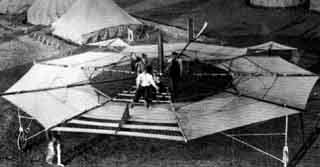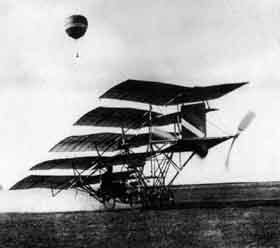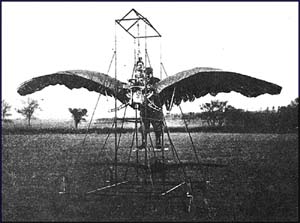In the early days of aviation, not all builders
were as systematic as the Wright brothers who carefully tested
each component of their machines and made adjustments to them
to gain maximum efficiently. Many builders took a more trial and
error approach to their designs. Below are some of the results:
 Louis
Bleriot would eventually build a plane that would be the first
to successfully cross the English Channel (with himself at
the controls), but this early powered glider, built to his
specifications by Gabriel Voisin, would never make it off
the surface of the Seine River where it was being tested. Louis
Bleriot would eventually build a plane that would be the first
to successfully cross the English Channel (with himself at
the controls), but this early powered glider, built to his
specifications by Gabriel Voisin, would never make it off
the surface of the Seine River where it was being tested. |
 This
vehicle was called the umbrellaplane. Built with a
circular wing and an engine in the center, it actually flew
several times at Chicago's Cicero Field. This flying-saucer-like
design was the work of Chance Vought, who would later become
an important aircraft builder. This
vehicle was called the umbrellaplane. Built with a
circular wing and an engine in the center, it actually flew
several times at Chicago's Cicero Field. This flying-saucer-like
design was the work of Chance Vought, who would later become
an important aircraft builder. |
 This
plane had four banks of slats and managed to hop about 500
feet in 1907. The brainchild of British designer Horatio Philips,
it had been inspired by an earlier, simpler version using
fewer slats that had flown as high as 50 feet. This
plane had four banks of slats and managed to hop about 500
feet in 1907. The brainchild of British designer Horatio Philips,
it had been inspired by an earlier, simpler version using
fewer slats that had flown as high as 50 feet. |
 This
strange French contraption with drum-like wings was inventive,
but produced little in the way of lift and never made it off
the ground. This
strange French contraption with drum-like wings was inventive,
but produced little in the way of lift and never made it off
the ground. |
 Another
plane with a drum-like design was the 1911 Geary Circular
Triplane. Although eventually triplanes would be successfully
flown, this one never made it off the ground. Another
plane with a drum-like design was the 1911 Geary Circular
Triplane. Although eventually triplanes would be successfully
flown, this one never made it off the ground. |
 In
an attempt to learn from nature the 1910 Burke "Seagull" had
a set of curved wings similar to its namesake. The machine
never flew, however. In
an attempt to learn from nature the 1910 Burke "Seagull" had
a set of curved wings similar to its namesake. The machine
never flew, however. |
 This
craft with five cambered wings was the design of Jerome S.
Zerbe. It attempted flight at a Los Angeles air meet in 1910,
but came apart before it could get into the air when it hit
a pothole in the airfield. This
craft with five cambered wings was the design of Jerome S.
Zerbe. It attempted flight at a Los Angeles air meet in 1910,
but came apart before it could get into the air when it hit
a pothole in the airfield. |
 Some
designers tried to follow the birds by building ornithopters
- planes the flap their wings. This 1890 version created by
E.P. Frost weighted 650 pounds and used steam-power to flap
a set of goose-feathered wings. It did not fly. Some
designers tried to follow the birds by building ornithopters
- planes the flap their wings. This 1890 version created by
E.P. Frost weighted 650 pounds and used steam-power to flap
a set of goose-feathered wings. It did not fly. |
 This
1908 Cornu helicopter with double rotors actually manged to
lift itself and its pilot off the ground for a very short
time. This
1908 Cornu helicopter with double rotors actually manged to
lift itself and its pilot off the ground for a very short
time. |
 This
aircraft was another Bleriot creation named Libellule,
the "butterfly," because of pairs of wings on the
front and back. Bleriot made short hops with it in 1907, but
on the last test flight, after he'd climbed to about 60 feet,
he lost control of the plane and it crashed to the ground.
Bleriot escaped without serious injury.. This
aircraft was another Bleriot creation named Libellule,
the "butterfly," because of pairs of wings on the
front and back. Bleriot made short hops with it in 1907, but
on the last test flight, after he'd climbed to about 60 feet,
he lost control of the plane and it crashed to the ground.
Bleriot escaped without serious injury.. |



 Louis
Bleriot would eventually build a plane that would be the first
to successfully cross the English Channel (with himself at
the controls), but this early powered glider, built to his
specifications by Gabriel Voisin, would never make it off
the surface of the Seine River where it was being tested.
Louis
Bleriot would eventually build a plane that would be the first
to successfully cross the English Channel (with himself at
the controls), but this early powered glider, built to his
specifications by Gabriel Voisin, would never make it off
the surface of the Seine River where it was being tested. This
vehicle was called the umbrellaplane. Built with a
circular wing and an engine in the center, it actually flew
several times at Chicago's Cicero Field. This flying-saucer-like
design was the work of Chance Vought, who would later become
an important aircraft builder.
This
vehicle was called the umbrellaplane. Built with a
circular wing and an engine in the center, it actually flew
several times at Chicago's Cicero Field. This flying-saucer-like
design was the work of Chance Vought, who would later become
an important aircraft builder. This
plane had four banks of slats and managed to hop about 500
feet in 1907. The brainchild of British designer Horatio Philips,
it had been inspired by an earlier, simpler version using
fewer slats that had flown as high as 50 feet.
This
plane had four banks of slats and managed to hop about 500
feet in 1907. The brainchild of British designer Horatio Philips,
it had been inspired by an earlier, simpler version using
fewer slats that had flown as high as 50 feet. This
strange French contraption with drum-like wings was inventive,
but produced little in the way of lift and never made it off
the ground.
This
strange French contraption with drum-like wings was inventive,
but produced little in the way of lift and never made it off
the ground. Another
plane with a drum-like design was the 1911 Geary Circular
Triplane. Although eventually triplanes would be successfully
flown, this one never made it off the ground.
Another
plane with a drum-like design was the 1911 Geary Circular
Triplane. Although eventually triplanes would be successfully
flown, this one never made it off the ground. In
an attempt to learn from nature the 1910 Burke "Seagull" had
a set of curved wings similar to its namesake. The machine
never flew, however.
In
an attempt to learn from nature the 1910 Burke "Seagull" had
a set of curved wings similar to its namesake. The machine
never flew, however. This
craft with five cambered wings was the design of Jerome S.
Zerbe. It attempted flight at a Los Angeles air meet in 1910,
but came apart before it could get into the air when it hit
a pothole in the airfield.
This
craft with five cambered wings was the design of Jerome S.
Zerbe. It attempted flight at a Los Angeles air meet in 1910,
but came apart before it could get into the air when it hit
a pothole in the airfield. Some
designers tried to follow the birds by building ornithopters
- planes the flap their wings. This 1890 version created by
E.P. Frost weighted 650 pounds and used steam-power to flap
a set of goose-feathered wings. It did not fly.
Some
designers tried to follow the birds by building ornithopters
- planes the flap their wings. This 1890 version created by
E.P. Frost weighted 650 pounds and used steam-power to flap
a set of goose-feathered wings. It did not fly. This
1908 Cornu helicopter with double rotors actually manged to
lift itself and its pilot off the ground for a very short
time.
This
1908 Cornu helicopter with double rotors actually manged to
lift itself and its pilot off the ground for a very short
time.  This
aircraft was another Bleriot creation named Libellule,
the "butterfly," because of pairs of wings on the
front and back. Bleriot made short hops with it in 1907, but
on the last test flight, after he'd climbed to about 60 feet,
he lost control of the plane and it crashed to the ground.
Bleriot escaped without serious injury..
This
aircraft was another Bleriot creation named Libellule,
the "butterfly," because of pairs of wings on the
front and back. Bleriot made short hops with it in 1907, but
on the last test flight, after he'd climbed to about 60 feet,
he lost control of the plane and it crashed to the ground.
Bleriot escaped without serious injury.. 